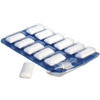Getting some extra help quitting: Nicotine replacement therapy
Quitters who use nicotine replacement therapy (NRT) are 50–70% more likely to stop smoking in the long term than those who do not use NRT. This is because coping with the withdrawals from nicotine can be the most difficult part of flicking the dart. With NRT, smokers can get a hit of their old friend (and foe) without sucking in a nasty cancer stick. However, it is not appropriate for everyone so you must speak with your doctor first. Consider your doc to be your best ally in the fight to flick the stick. They may even suggest other therapies which may be more effective in your particular case.
How does it work?
NRT works by replacing slightly less nicotine than the smoker is dependant on. The dose is gradually withdrawn, so the ex-smoker reduces their dependence on nicotine gradually over a period of 8–16 weeks.
There are different ways of taking NRT. Once upon a time, it was only administered through patches on the skin, but now you can take lozenges, chewing gum, tablets and inhalers.
Who’s an oxymoron?
It may initially seem weird that you should ingest nicotine so you can quit nicotine. But if you are already exposed to nicotine at dangerously high doses, going cold turkey may be too difficult, so you may choose to ease out of the addiction slowly.
NRT is far safer than continuing to smoke – it gives the ex-smoker a nicotine hit without all the other toxic chemicals they cop by smoking a cigarette.
NRT 4 ME?
There are many ways to undertake NRT, so it is essential you get the doc’s help in figuring out the best way for you. This is part of what will make your therapy successful.
For example, if you’re on two packs of cigs a day, then you’re considered to be a very heavy smoker. Your doctor will need to determine the best dose for you.
Sometimes really heavy smokers receive dual therapy, like a patch to continually supply a constant level of nicotine to the blood, used in combination with chewing gum that can be taken for a quick nicotine hit when you feel the urge to smoke.
This way, heavy smokers can cut down on the number of cigarettes they smoke each day.
If you’re more of a ‘cigarette-with-a-cocktail’ smoker and you’d like to give up the social smoking, then perhaps gum may be best for you. Talking to your doctor will help you find the best course of action to take back your lungs and your life.
Don’t make your baby smoke
If you are pregnant or breastfeeding, smoking is a big no-no. It is far better for you to receive NRT than for you to smoke actual cigarettes, especially if you need to cut right down.
Pregnant or breastfeeding women certainly cannot take NRT and smoke at the same time, because the foetus will get a double hit of nicotine, and this will cause damage to your baby.
There are risks with NRT in association to pregnancy too, like restricted foetal growth. So if you are planning to welcome a little bundle into the world, then the best time to put a stop to the smoking is before you get pregnant.
The teen scene
NRT can sometimes be prescribed for smoking teenagers, but only when a doctor is absolutely convinced the teen is addicted. This is because teenagers often smoke to ‘fit in’ or due to peer pressure. Remember how hard it was to be adolescent? Sometimes counselling is more suitable.
Also, teens have to been reminded that NRT cannot be shared with mates and it doesn’t mean you can keep smoking.
Funeral for a friend
With everything we now know about smoking, it’s certainly time to bury the smokes forever. Luckily, docs have many tricks up their sleeves for helping you to kick this dangerous habit, so speak with them about the options.
You may feel that cigarettes have been like an old faithful friend – but your lungs are your only real flesh and blood.
More information
 | For more information, see Nicotine Replacement Therapy (NRT). |
Dates
Created by:

 Login
Login














